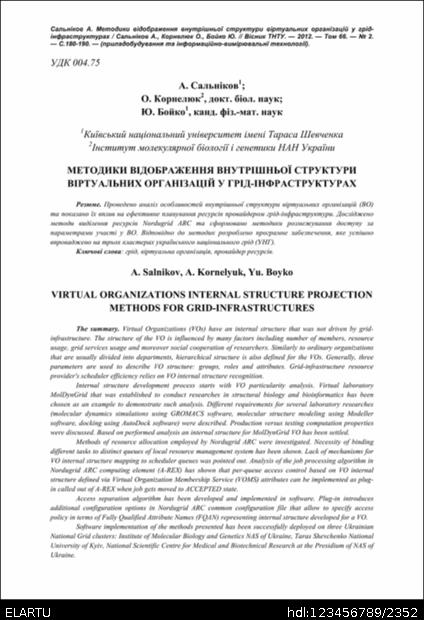Mesedez, erabili identifikatzaile hau item hau aipatzeko edo estekatzeko:
http://elartu.tntu.edu.ua/handle/123456789/2352

| Titulua: | Методики відображення внутрішньої структури віртуальних організацій у грід-інфраструктурах |
| Beste titulu batzuk: | Virtual organizations internal structure projection methods for grid-infrastructures |
| Egilea: | Сальніков, Андрій Олександрович Корнелюк, Олександр Іванович Бойко, Юрій Володимирович Salnikov, A. Kornelyuk, A. Boyko, Yu. |
| Bibliographic description (Ukraine): | Сальніков А. Методики відображення внутрішньої структури віртуальних організацій у грід-інфраструктурах / Сальніков А., Корнелюк О., Бойко Ю. // Вісник ТНТУ. — 2012. — Том 66. — № 2. — С.180-190. — (приладобудування та інформаційно-вимірювальнї технології). |
| Gordailuaren-data: | 15-Feb-2012 |
| Date of entry: | 26-Jun-2013 |
| Argitalpen: | Тернопільський національний технічний університет ім. Івана Пулюя |
| Place of the edition/event: | Тернопіль, Україна |
| UDC: | 004.75 |
| Gako-hitzak: | грід віртуальна організація провайдер ресурсів grid virtual organization resource provider |
| Laburpena: | Проведено аналіз особливостей внутрішньої структури віртуальних організацій (ВО) та показано їх вплив на ефективне планування ресурсів провайдером грід-інфраструктури. Досліджено методи виділення ресурсів Nordugrid ARC та сформовано методики розмежування доступу за параметрами участі у ВО. Відповідно до методик розроблено програмне забезпечення, яке успішно впроваджено на трьох кластерах українського національного грід (УНГ). Virtual Organizations (VOs) have an internal structure that was not driven by grid-infrastructure. The structure of the VO is influenced by many factors including number of members, resource usage, grid services usage and moreover social cooperation of researchers. Similarly to ordinary organizations that are usually divided into departments, hierarchical structure is also defined for the VOs. Generally, three parameters are used to describe VO structure: groups, roles and attributes. Grid-infrastructure resource provider's scheduler efficiency relies on VO internal structure recognition. Internal structure development process starts with VO particularity analysis. Virtual laboratory MolDynGrid that was established to conduct researches in structural biology and bioinformatics has been chosen as an example to demonstrate such analysis. Different requirements for several laboratory researches (molecular dynamics simulations using GROMACS software, molecular structure modeling using Modeller software, docking using AutoDock software) were described. Production versus testing computation properties were discussed. Based on performed analysis an internal structure for MolDynGrid VO has been settled. Methods of resource allocation employed by Nordugrid ARC were investigated. Necessity of binding different tasks to distinct queues of local resource management system has been shown. Lack of mechanisms for VO internal structure mapping to scheduler queues was pointed out. Analysis of the job processing algorithm in Nordugrid ARC computing element (A-REX) has shown that per-queue access control based on VO internal structure defined via Virtual Organization Membership Service (VOMS) attributes can be implemented as plug-in called out of A-REX when job gets moved to ACCEPTED state. Access separation algorithm has been developed and implemented in software. Plug-in introduces additional configuration options in Nordugrid ARC common configuration file that allow to specify access policy in terms of Fully Qualified Attribute Names (FQAN) representing internal structure developed for a VO. Software implementation of the methods presented has been successfully deployed on three Ukrainian National Grid clusters: Institute of Molecular Biology and Genetics NAS of Ukraine, Taras Shevchenko National University of Kyiv, National Scientific Centre for Medical and Biotechnical Research at the Presidium of NAS of Ukraine. Example of plug-in configuration considering particularities of Institute of Molecular Biology and Genetics NAS of Ukraine cluster has been shown. Methods are applicable to the other grid-enabled clusters. |
| URI: | http://elartu.tntu.edu.ua/handle/123456789/2352 |
| ISSN: | 1727-7108 |
| Copyright owner: | © „Вісник Тернопільського національного технічного університету“ |
| Publications status : | Опубліковано раніше |
| Content type: | Article |
| Bildumetan azaltzen da: | Вісник ТНТУ, 2012, № 2 (66) |
Item honetako fitxategiak:
DSpaceko itemak copyright bidez babestuta daude, eskubide guztiak gordeta, baldin eta kontrakoa adierazten ez bada.